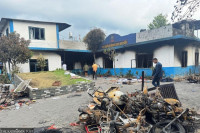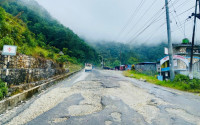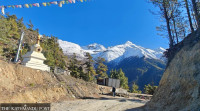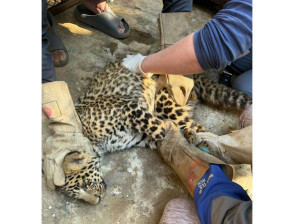Gandaki Province
Villagers in North Gorkha rely on mules to bring in essential goods
People of the remote villages have to pay three times the actual cost to bring in essentials, including food, clothes and construction materials, on mules.
Hariram Upreti
The northern villages of Gorkha district are unreachable by road. Cut off from the urban centres of the district, the villagers have to either subsist on their local farm produce, which is far from sufficient, or import goods—including food items—on mules.
Surviving on minimum available resources of food, clothing and other necessities, the villagers do not have many options but to rely on mules to bring in daily essentials.
Pemba Tsering, a 60-year-old man from Ranagaun in Chumanuwri Rural Municipality-5, one of the remote villages in northern Gorkha, says he does not even have the luxury to depend on his farm produce to see him through the year since whatever little crops he manages to grow become fodder for wild monkeys.
“I don’t have the means to keep monkeys away from my crops. So I have stopped tending to my field,” said Tsering. “I work in other people’s fields as a farmhand and do odd jobs to make a living.”
There are seven wards in Chumanuwri Rural Municipality and none of them is connected to motorable roads. Everything from construction materials to food and clothes are transported to these remote villages on mules for which locals end up paying thrice the actual cost.
Saila Lama of Namrung in Ward No 4 of the rural municipality says although mules have come as a relief to the rural population, not many people can afford the goods brought to the villages on mules.
“We have to pay an exorbitant price to the traders for goods brought by the mules,” said Lama. “The other option is to use helicopters to import goods to the villages but the price for such a service is very high.”
According to Jeevan Gurung of Boor in Ward No 5 of the rural municipality, the cost for mules to transfer goods to different villages varies depending on the distance to be covered from Aarughat, a market centre in Gorkha.
“Mule owners fix the transportation fare for northern Gorkha villages. In my village, a packet of salt costs Rs 70 whereas the actual cost is Rs 20. Rs 50 is the transportation fee,” said Gurung.
However, the villagers cannot fully rely on mule transportation because the weather conditions can turn unfavourable for the movement of mules through rough terrain.
“If the mules fail to bring food supplies to the villages, we are at risk of going hungry,” said Kalten Lama of Lihi in Ward No 2 of the rural municipality. “The potatoes I grow in my field do not last long. We are solely dependent on mules to bring us food from the lower regions of Gorkha and the markets of Tibet. But the pandemic saw the closure of two northern checkpoints with China. Now we have access only to Aarughat.”
“When I run out of money to pay for mule transport, I carry the goods myself and bring them home. It takes me three days to reach home,” he said.
Residents of Samagau, Chhekampar, Chumchet, Vihi, Lho, Prok and Sirdiwas in the rural municipality have no other option but to carry goods on their back when mule transportation becomes unaffordable.
According to Ghirme Lama of Namrung, the rainy season brings more misery to the villagers since the Manaslu footpath used by mule traders becomes unusable.
“The route is blocked during the rainy season and it becomes risky even for humans to walk the trail,” said Ghirme. “We can do nothing but wait for the rains to stop so the mules can resume their movement.”
There is a government-run food depot in Philim of Chumanuwri Rural Municipality but it takes at least two days on foot for residents of far-flung villages such as Samagau in northern Gorkha to reach Philim. The subsidy provided by the government does not provide much relief to the villagers because they have to pay twice the amount of the given subsidy to transport the goods to their villages on mules.
The residents of Chumchet, Chhekampar, Lho, Prok and Vihika have to pay exorbitant prices to bring in rice from the food depot in Philim.
A meeting of the District Food Management Committee on January 3, 2017, proposed to set up an additional depot in Namrung for the benefit of northern Gorkha villagers but no decision has been taken so far.
Navin Basnet, head of Food Management and Trading Company Limited Gorkha, said that the company will take initiative to set up a distribution centre in Namrung next year.
“Until the construction of the depot is completed, a distribution centre will be set up at Namrung in Ward No 4 to sell rice for the ease of the local residents. There are food depots in Philim and Machakhola for selling rice at concessional rates in North Gorkha where there is no paddy cultivation,” said Basnet.
Aside from their daily necessities, villagers across Chumanuvri Rural Municipality also have to pay a high price for bringing in construction materials.
According to Tsering Lama of Chekampar, the construction of most of the houses destroyed by the 2015 earthquake has yet to be completed due to the lack of motorable roads.
“We have to bring everything from rods, cement to zinc sheets on mules. The government's grant of Rs 300,000 to build a house is not enough to pay for the transportation charge of the goods,” said Tsering Lama. “Around Rs 400,000 to 500,000 is spent on transportation alone while building a simple house in the village. The government grant does not cover the total reconstruction cost so most of the villagers are still living in damaged or half-built houses.”
The Nepal Army has opened a road track from Aarughat-Larke to Machhakhola but the road becomes unmotorable during the rainy season so the villagers have to rely on mules to bring in goods from Soti in Aarughat-4.



 10.12°C Kathmandu
10.12°C Kathmandu.jpg)











